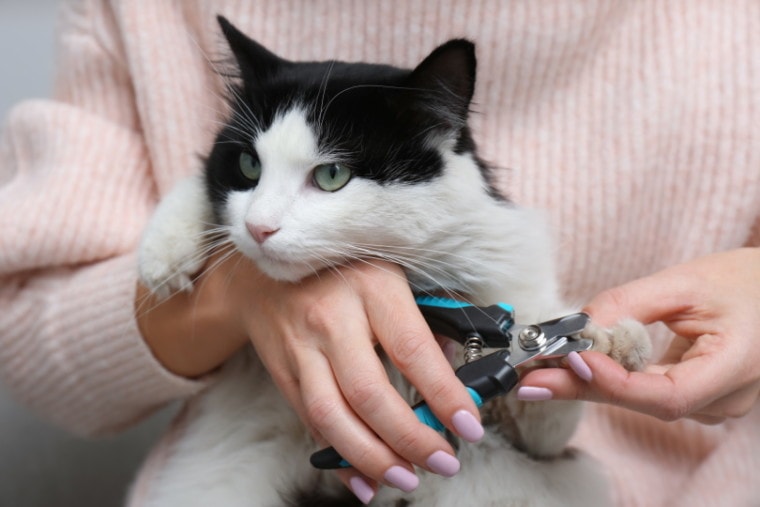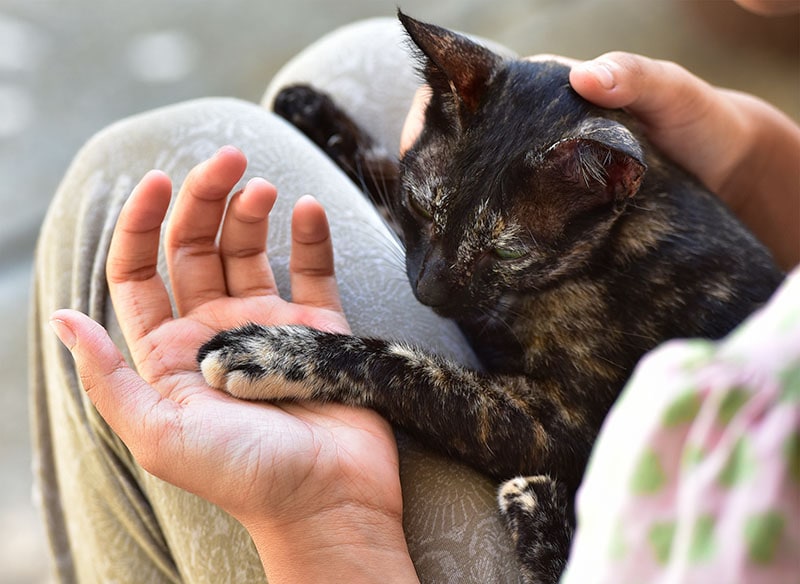
Other than cleaning the litter box, trimming your cat’s nails may sound like one of the more unpleasant parts of owning a cat. But it doesn’t have to be.
Trimming your cat’s nails is a necessary part of taking care of a cat. Not only can long claws cause damage to you and your belongings, but they can also get caught in things, causing discomfort and damage to the claws. A cat that feels trapped will panic, and injury is always a possibility. Not all cats need their nails trimmed, but it’s good to get them used to it in case they require it at any point in their life.
The longer a cat’s nails get, the more likely that they’ll grow into the pads (a.k.a. the toe beans) of their paws, which as you can imagine, can be excruciatingly painful! This will require prompt veterinary attention.
So, you know that nail trimming is important, and for some cats, it needs to be done regularly. But how do you start? Keep reading, as we give you all kinds of tips and tricks to make this process less stressful!
The 5 Steps for Trimming Your Cat’s Nails at Home
1. Paw, Meet Hand
One of the most important things that you can do is get your cat used to having their paws handled. It’s ideal to start this when they are kittens, but you can still go through this process even when they are adults.
If your cat dislikes having their paws touched, you’ll need to do a few things so your cat will become more comfortable with being touched and handled.
Wait until your cat is relaxed, and then gently hold and rub one paw for a few seconds. If your cat tries to remove their paw from your grasp, move with it. Then, squeeze the paw (gently) until at least one nail extends. Immediately let the paw go and give your cat a treat.
You’ll want to repeat this procedure two to three times a day until your cat starts to get used to it and doesn’t seem to mind it as much.

2. Cat, Meet Nail Clippers
Cats can be quite scared of items that they are not familiar with, and nail clippers are no exception. Start by leaving them out for your cat to sniff and explore on their terms. If your cat seems reluctant to approach them, place a treat near them.
The other part of nail trimmers that cats might not appreciate is the sound that they make while clipping. If your cat is particularly nervous, start by using a piece of dry spaghetti and cutting it while your cat is around and watching.
You can eventually try this when your cat is on your lap: Gently touch your cat’s paw, then clip the spaghetti, and give your cat a treat afterward.
3. It’s All About the Atmosphere
Before you even think about trimming your cat’s nails, you need to be sure the environment is quiet and peaceful. You don’t want this to take place near windows or in an area where there might be a great deal of activity. This will prove distracting and might add to your cat’s stress.
You should also wait until your cat is calm. After your cat has eaten a meal or after a nap, your cat should be sleepy and feel more at ease. After a play session with Catnip might also be a great time.

4. Time to Take the Clipping Plunge
If your cat seems to accept having their paws touched, it’s time to take the plunge and try your first trim. Be sure to familiarize yourself with the technique first, and consider practicing for the first time at your vet’s.
Place your cat in your lap, facing the opposite direction. Take one of their paws (it’s best to start with the front paws), and gently press it until the claw extends out. You’ll only want to trim the sharp white end and avoid the pink quickly. Once you’ve clipped one claw, let the paw go and give your cat a treat. If your cat seems to be doing okay, try another nail.
Most cats start to become restless after having two to three nails trimmed, so as soon as you can tell that your cat has had enough, let them go. Give your cat a treat, or play with them using a favorite toy. This way, they’ll start to associate nail trims with positive things.
You’ll probably need to do these steps multiple times to get all your nails trimmed. Don’t expect to accomplish a nail trim in one sitting.
Keeping your cat's nails trimmed is important, but it's no one's favorite task. You can make it easier with great clippers designed specifically for cats. We like Hepper's Cat Nail Clipper Set, a convenient combination of medium and small clippers that comes in a handy pouch. These sharp stainless steel clippers allow for precision trimming, with the added protection of built-in safety guards. Plus, there's a hidden nail file!
At Pet Keen, we've admired Hepper for many years, and decided to take a controlling ownership interest so that we could benefit from the outstanding designs of this cool cat company!
5. The Dreaded Quick
A lucky thing for cat owners is that most cats have semi-transparent nails, so it’s much easier to see the quick (unlike for black-nailed dogs). When you look closely, you should see a kind of pink stripe at the base of the nail.
When you trim a cat’s nails, you need to stay clear of the quick, as this is a nerve ending that also contains blood vessels and can cause pain and bleeding if you clip it. You should have styptic powder on hand, which will stop the bleeding. Still, it’s best to cut too little from your cat’s nails than too much.

Types of Nail Trimmers
There are many tools that you can use to trim your cat’s claws. Some will work better for you, while others might work best for your cat. Here are a few options:
The quality of the jaws of the clippers is paramount. If the inside of the jaws are too dull or do not close properly, you’ll end up damaging the nail rather than getting a nice, clean cut. You might need to try out more than one until you find what you’re most comfortable using.
Image Credit: Anna Hoychuk, Shutterstock
What If Your Cat Doesn’t Like Being Held?
Not all cats love to be held or enjoy lying on your lap. So, what do you do if you don’t have a lap cat?
One option is to place your cat on a table, or if your cat loves hanging out on a shelf or cat tree that’s at a comfortable level for you, you can try it there. This could work well because this is where your cat will also feel relaxed and safe.
You can also ask for help if there is someone in your household or if you have a friend or family member who doesn’t mind dropping by to help out on nail trim day. Having a helper will free up your hands, and they can try petting and distracting your cat while you sneak in a claw trim or two.
Other Options
If your cat is particularly stressed throughout this process, you can consider using a product designed to calm a stressed cat. There are calming treats and products like Feliway and Rescue Remedy. You can even put on music and sounds, like this calming music speaker specially designed for cats.
If your cat is particularly upset about nail trimming, some people like to use the burrito method. This involves wrapping your cat up in a towel or blanket like a burrito to restrain them, which can calm some cats down.
There are also grooming bags, but you should only use this method if your cat doesn’t mind being wrapped up. Not all cats will respond favorably to this form of restraint. Some cats might respond better if you cover their heads so they can’t see what you’re doing.
If you’re worried about your cat biting, you can use a cat muzzle or even an inflatable donut to put around their neck, as they won’t be able to reach you.
Your best bet is to try the slow but steady steps on this list. The calmer your cat is, the less stressed everyone else will be.










